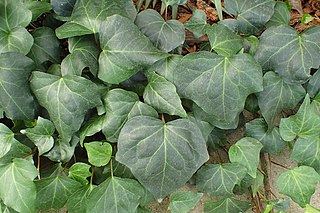
Hedera, commonly called ivy, is a genus of 12–15 species of evergreen climbing or ground-creeping woody plants in the family Araliaceae, native to western, central and southern Europe, Macaronesia, northwestern Africa and across central-southern Asia east to Japan and Taiwan.
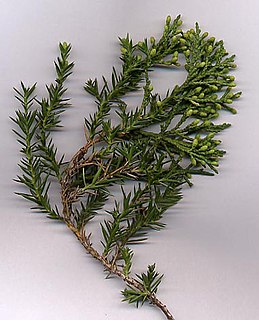
Juniperus chinensis, the Chinese juniper is a species of plant in the cypress family Cupressaceae, native to China, Myanmar, Japan, Korea and the Russian Far East. Growing 1–20 metres tall, it is a very variable coniferous evergreen tree or shrub.

Berberis, commonly known as barberry, is a large genus of deciduous and evergreen shrubs from 1–5 m (3.3–16.4 ft) tall, found throughout temperate and subtropical regions of the world. Species diversity is greatest in South America and Asia; Europe, Africa and North America have native species as well. The best-known Berberis species is the European barberry, Berberis vulgaris, which is common in Europe, North Africa, the Middle East, and central Asia, and has been widely introduced in North America. Many of the species have spines on the shoots and all along the margins of the leaves.
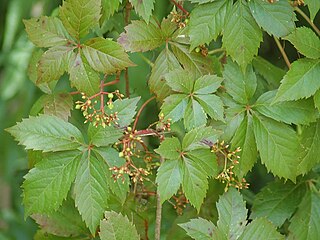
Parthenocissus quinquefolia, known as Virginia creeper, Victoria creeper, five-leaved ivy, or five-finger, is a species of flowering vine in the grape family, Vitaceae. It is native to eastern and central North America, from southeastern Canada and the eastern United States west to Manitoba and Utah, and south to eastern Mexico and Guatemala.

Hedera hibernica, common name Atlantic ivy, Boston Ivy or Irish ivy, is a woody vine native to the Atlantic coast of Europe.

Hedera helix, the common ivy, English ivy, European ivy, or just ivy, is a species of flowering plant of the ivy genus in the family Araliaceae, native to most of Europe and western Asia. A rampant, clinging evergreen vine, it is a familiar sight in gardens, waste spaces, and wild areas, where it grows on walls, fences, tree trunks, etc. across its native and introduced habitats. As a result of its hardy nature, and its tendency to grow readily without human assistance, ivy attained popularity as an ornamental plant, but escaped plants have become naturalised outside its native range and grow unchecked in myriad wild and cultivated areas.
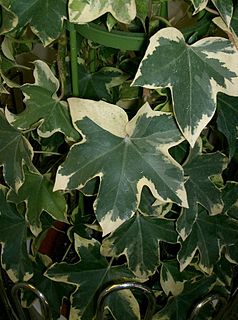
×Fatshedera is hybrid genus of flowering plants, common name tree ivy or aralia ivy. It has only one species, ×Fatshedera lizei. The hybrid symbol × in front of the name indicates that this is an inter-generic hybrid, a cross between plants from different genera. The name may be displayed with or without a space after the × symbol.

Fatsia japonica, also glossy-leaf paper plant, fatsi, paperplant, false castor oil plant, or Japanese aralia, is a species of flowering plant in the family Araliaceae, native to southern Japan and southern Korea.
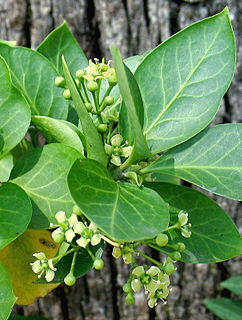
Euonymus fortunei, the spindle, Fortune's spindle, winter creeper or wintercreeper, is a species of flowering plant in the family Celastraceae, native to east Asia, including China, Korea, the Philippines and Japan. It is named after the Scottish botanist and plant explorer Robert Fortune. Euonymus is highly invasive and damaging in the United States, causing the death of trees and forest in urban areas.

Schefflera taiwaniana (台湾鹅掌柴) is a species of flowering plant in the family Araliaceae, native to Taiwan, where it is scattered throughout coniferous forests at 2,000–3,000 m (6,600–9,800 ft). Growing to 4 m (13 ft) tall by 2.5 m (8.2 ft) broad, it is an evergreen shrub or small tree. Large leaves up to 15 cm (5.9 in) long are composed of up to 11 ovate leaflets arranged radially around a central stalk. Young leaves are covered in silver hairs, while mature leaves have a smooth surface. Sprays of flowers in late summer are followed by dark berries in winter - a valued food source for insects and birds.

Cyclamen hederifolium, the ivy-leaved cyclamen or sowbread, is a species of flowering plant in the family Primulaceae. This widespread cyclamen species is widely cultivated and among the most hardy and vigorous in oceanic climates. It is native to woodland, shrubland, and rocky areas in the Mediterranean region from southern France to western Turkey and on Mediterranean islands, and naturalized farther north in Europe and in the Pacific Northwest.
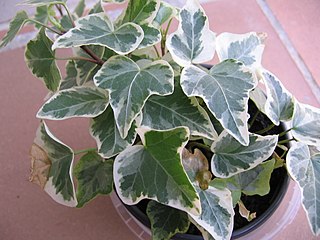
Hedera algeriensis, the Algerian ivy, is a species of evergreen ivy native to the North African coast, including coastal mountains in Algeria.

Hedera canariensis, the Canary Island ivy, Canary ivy or Madeira ivy, is a species of ivy, native to the Canary Islands and possibly the Atlantic coast of northern Africa.
Hedera maderensis, the Madeiran ivy, is a species of ivy which is native to the Atlantic coast in Madeira island. It is a plant of botanical family Araliaceae, species endemic to the island of Madeira with the name: Hedera maderensis. Formerly a subspecies named Hedera maderensis iberica, one iberian subspecies in west Iberian peninsula was subsequently classified as a distinct species. It is quite common in Madeira and lives in slopes rock, soil, trunks of trees especially in Laurel forest of Barbusano.

Hedera maroccana, the Moroccan ivy, is a species of ivy which is native to the Atlantic coast in northern Africa. It is an evergreen climbing plant, growing to 20–30 m high where suitable surfaces are available, and also growing as ground cover where there are no vertical surfaces. It climbs by means of aerial rootlets which cling to the substrate. In warm climates, it grows more rapidly and becomes established a good bit faster than the related Hedera hibernica and Hedera helix.

Hedera iberica is a species of ivy which is native to the western Iberian peninsula, and northern Morocco. It was formerly classified as a sub-species named Hedera maderensis iberica in Hedera maderensis. The Iberian subspecies was subsequently classified as a distinct species. It grows on slopes, rock, soil, trunks of trees.

Hedera azorica, the Azores ivy, is a species of ivy which is native to the Atlantic coast in the Azores Islands. It is an evergreen climbing plant, growing to 20–30 m high where suitable surfaces are available, and grows as ground cover where there are no vertical surfaces. It climbs by means of aerial rootlets which cling to the substrate.
Hedera cypria, is a species of Ivy which is endemic to the island of Cyprus. It is an evergreen climbing plant, growing slowly to 20–30 m high where suitable surfaces are available, and also growing as ground cover where there are no vertical surfaces. It climbs by means of aerial rootlets which cling to the substrate. It is more common at higher altitudes in rocky, shadowy riverine forest, over 400–650 m. In its natural habitat it can be distinguished easily from Hedera helix subsp. poetarum, also present, because the latter has yellow fruits, while Hedera cypria is always black-fruited.
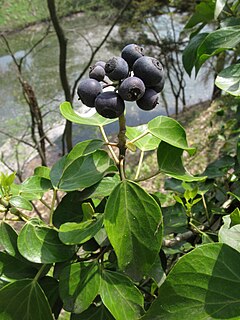
Hedera rhombea, the Japanese ivy or songak, is a species of ivy in the Araliaceae family native to East Asia. Formerly named Hedera pedunculata, some subspecies could be subsequently classified as a distinct species. It is common on rocky slopes and growing up the trunks of trees, especially in laurel forest, a type of cloud forest.
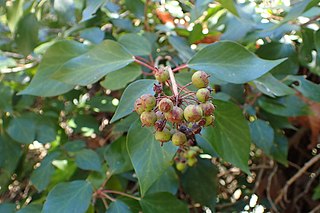
Hedera pastuchovii, (Araliaceae) is a species of ivy native to eastern Transcaucasia and listed in The Red Book of the Azerbaijan SSR, 1989.


















